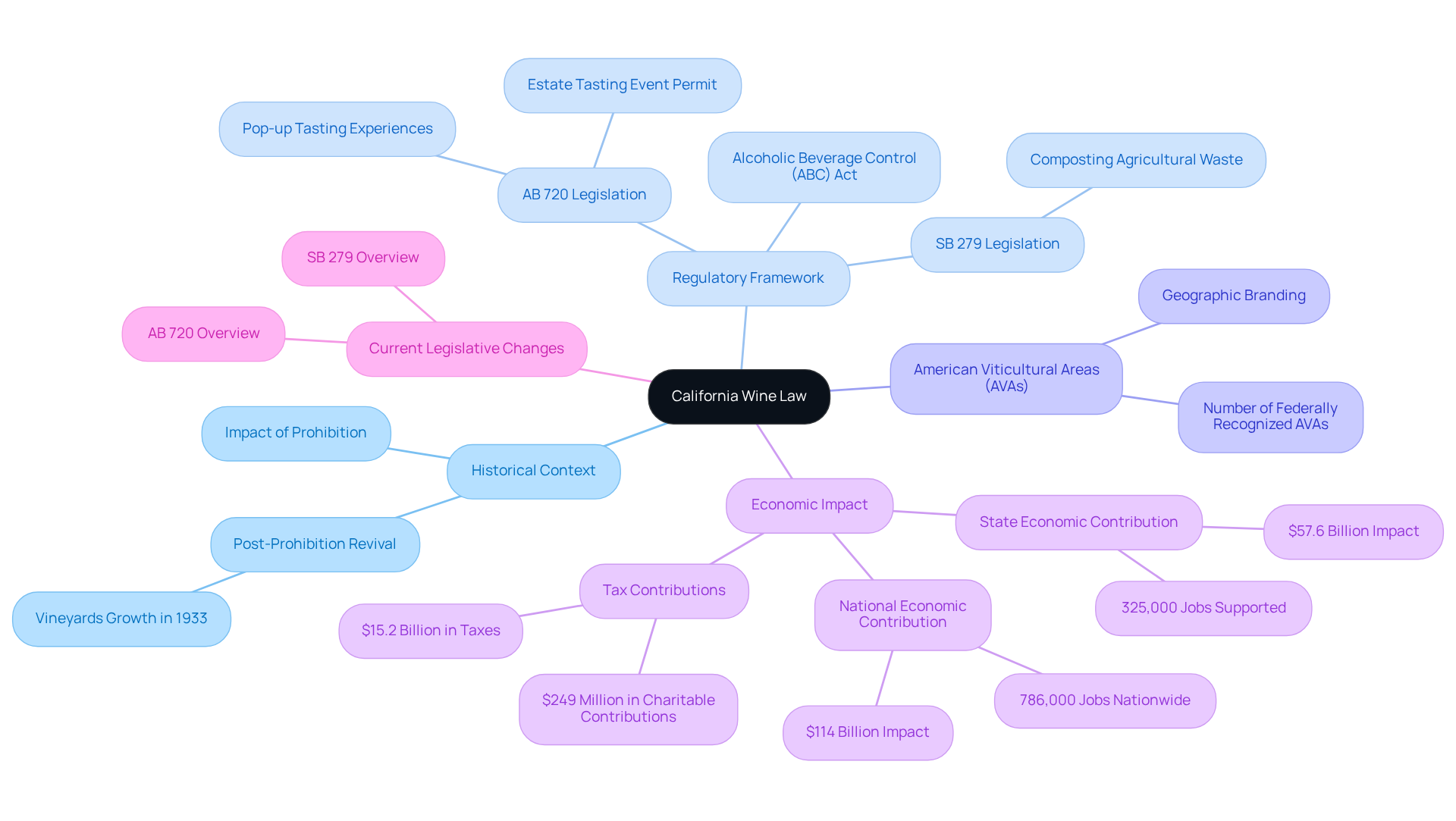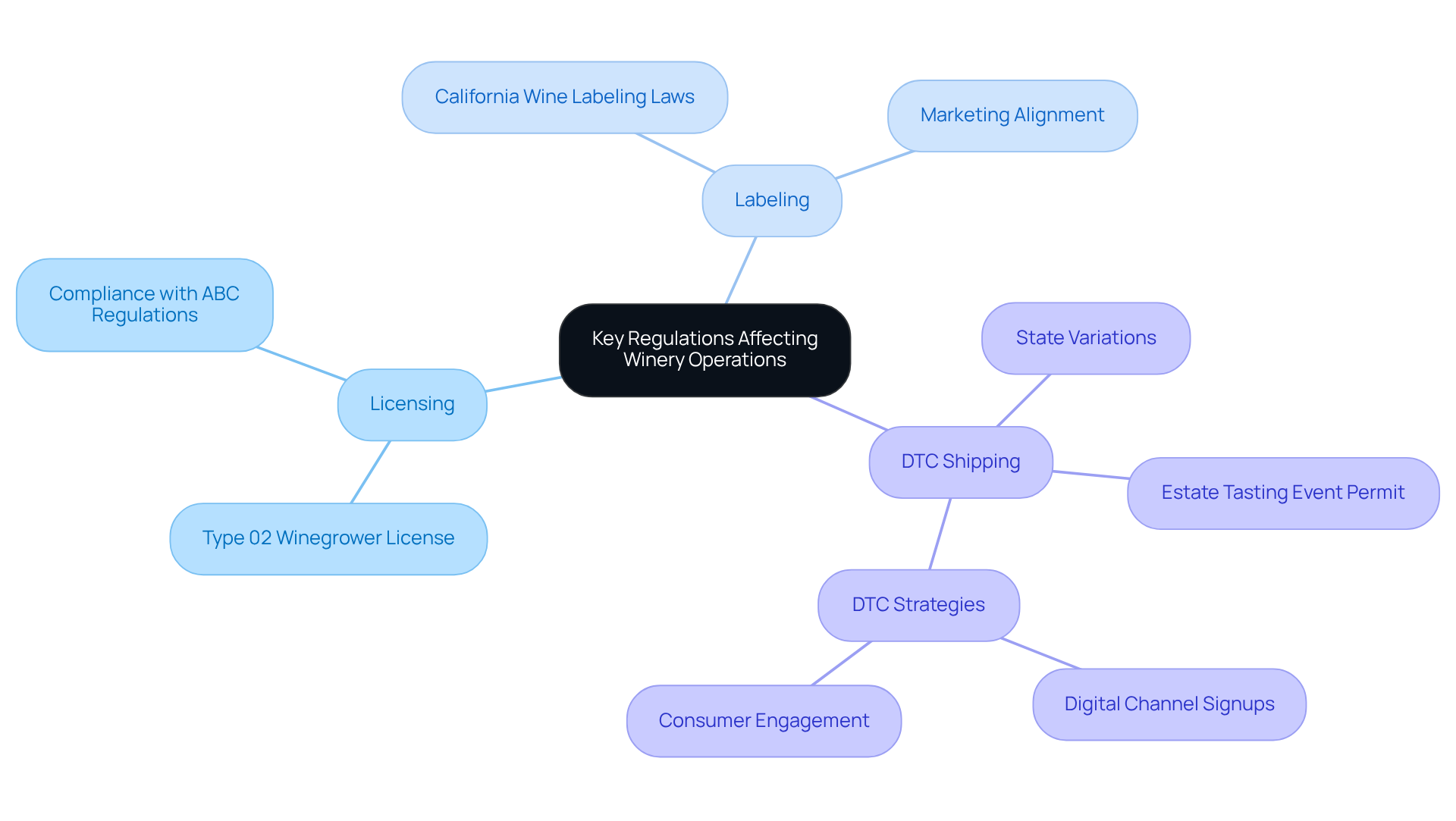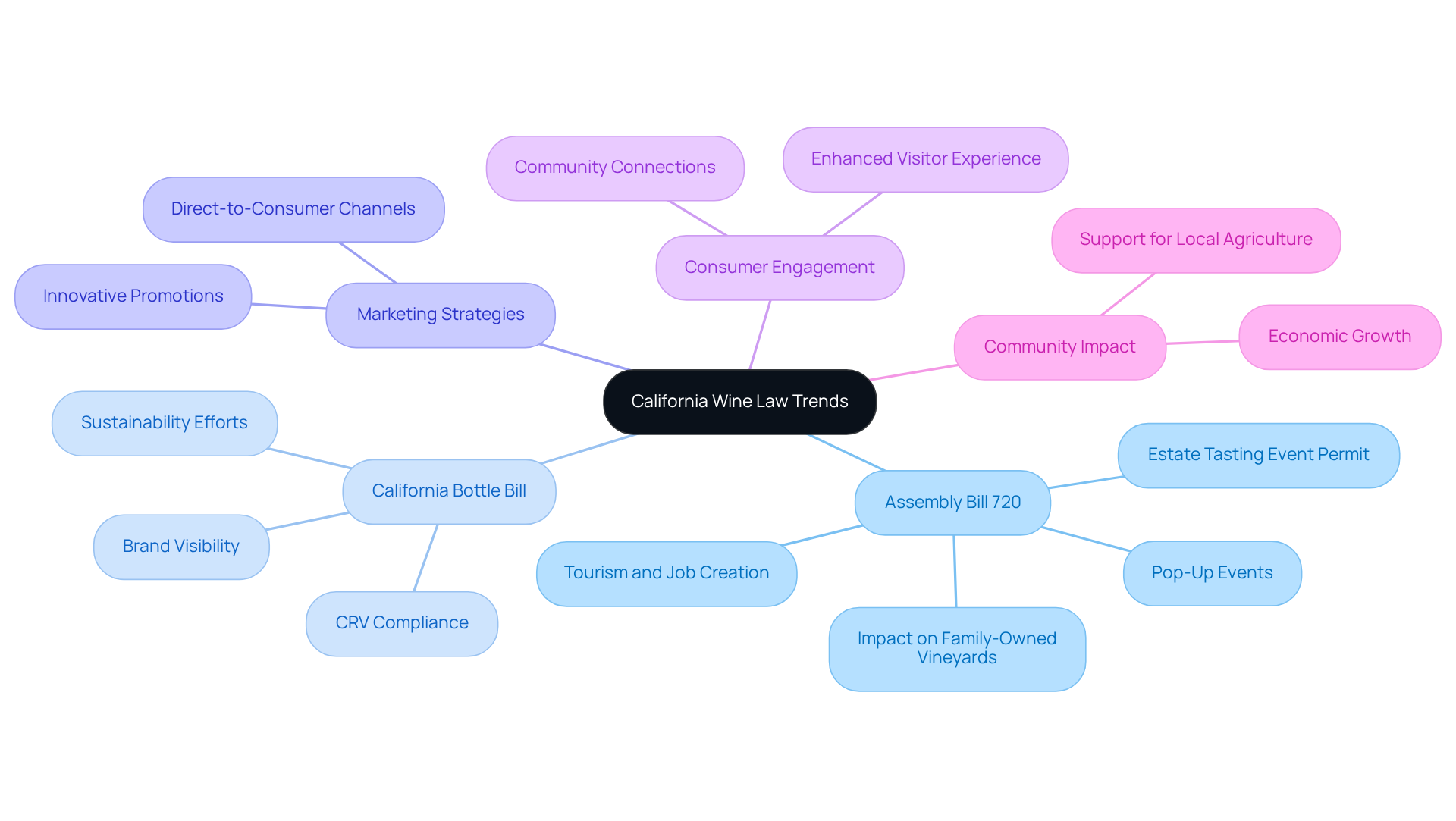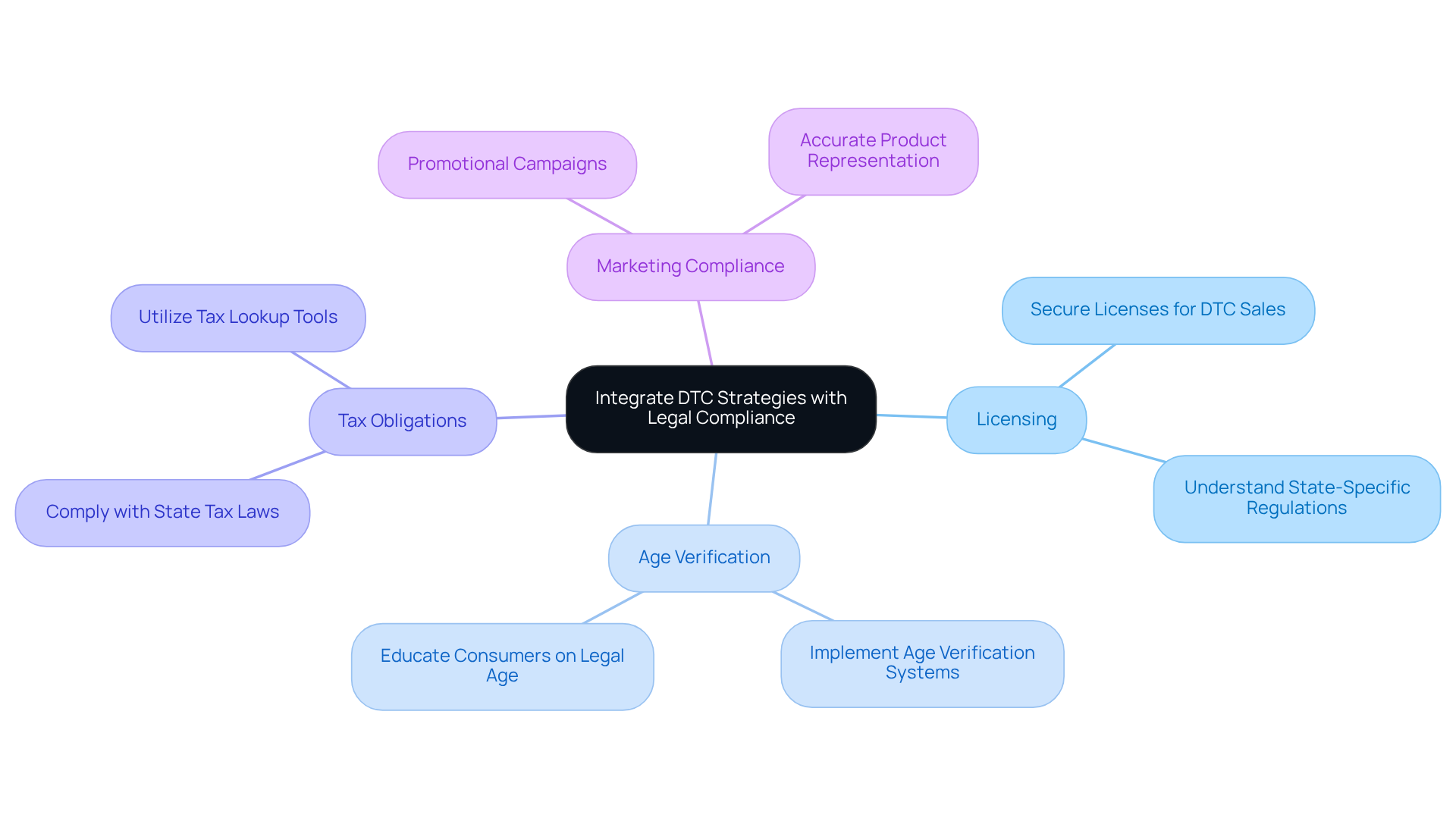Overview
This article presents crucial insights into California wine law that winery marketing directors must grasp to adeptly navigate the regulatory landscape. A comprehensive understanding of these laws—including licensing, labeling, and recent legislative changes such as AB 720—is essential for optimizing marketing strategies. By enhancing direct-to-consumer engagement, wineries can drive growth in an increasingly competitive market. Recognizing these legal intricacies not only empowers marketing directors but also positions their wineries for success.
Introduction
Understanding the intricate landscape of California wine law is essential for winery marketing directors navigating a competitive industry. This legal framework, shaped by a rich history that includes Prohibition and evolving regulations, not only impacts compliance but also presents strategic opportunities for enhancing consumer engagement and brand storytelling.
As new legislation emerges—such as Assembly Bill 720—the pressing question is: how can wineries effectively align their marketing strategies with these legal changes to foster growth and loyalty among consumers?
Explore the Foundations of California Wine Law
The California wine law is shaped by a complex framework of state regulations, federal laws, and local ordinances, with the Alcoholic Beverage Control (ABC) Act serving as a cornerstone for the production, distribution, and sale of alcoholic beverages within the region. The legacy of Prohibition, which severely restricted wine production and consumption, has had a profound impact on California wine law. Following the repeal of Prohibition, the quantity of vineyards in California soared from 177 at the start of 1933 to 380 by the conclusion of that year, indicating a notable revival in the sector. This historical context is essential for directors in the beverage industry, as comprehending California wine law enables them to navigate the present legal landscape efficiently while improving cash flow and direct-to-consumer interaction through strategic advisory services such as those provided by Enocap.
The creation of American Viticultural Areas (AVAs) emerged as a critical development, enabling producers to define the quality and origin of their products. With 141 federally recognized AVAs throughout the state, producers can utilize in their promotional efforts, enriching their storytelling and engaging more profoundly with consumers. As Natalie Collins, President of the California Association of Winegrape Growers, noted, grasping the California wine law is crucial for producers to succeed in a competitive market. Enocap's DTC Knowledge and Market Insight can further enable promotional directors to capitalize on these opportunities by converting casual buyers into devoted club members through established methods.
By aligning promotional approaches with California wine law, winery directors can ensure compliance while maximizing their market presence. Additionally, the California wine industry has a substantial economic impact, contributing $57.6 billion to the state economy and supporting 325,000 jobs. This underscores the importance of understanding California wine law for effective marketing strategies. Recent legislative changes, such as AB 720, further illustrate the evolving landscape shaped by California wine law, providing new opportunities for wine producers to engage with consumers through innovative tasting experiences and strategic capital planning, ensuring sustainable growth for family-owned businesses.

Navigate Key Regulations Affecting Winery Operations
Key regulations exert a significant influence on winery operations, particularly concerning licensing, labeling, and direct-to-consumer (DTC) shipping. To legally produce and sell wine, wineries must secure a Type 02 Winegrower License in accordance with California wine law from the California Department of Alcoholic Beverage Control (ABC). Adherence to both federal and state labeling laws, particularly the California wine law, is paramount; for instance, wines labeled as 'California' must consist of 100% grapes sourced from the state. This stipulation emphasizes the need for marketing directors to align promotional materials and sales strategies with California wine law to avoid potential violations.
In 2025, vineyards will also need to navigate the intricate DTC shipping regulations that differ by state. This complexity demands a comprehensive understanding of compliance requirements to facilitate successful sales directly to consumers. Notably, the recent introduction of the Estate Tasting Event Permit allows establishments to host 'pop-up' tasting experiences at their estate vineyard locations, thereby enhancing consumer engagement while adhering to legal frameworks.
To thrive in this regulatory landscape, vineyards should focus on converting casual customers into committed club members through . Statistics indicate that 27% of new wine club signups now originate from digital channels, underscoring the significance of robust compliance strategies in maximizing DTC sales. Additionally, resources such as the tax lookup service available to Wine Institute members offer current sales and excise tax rates, aiding producers in understanding their tax responsibilities for both on-site and off-site sales. Strategic capital planning is also vital for vineyards to adeptly navigate these regulations and invest in sustainable growth. By leveraging these resources and concentrating on brand storytelling, vineyards can better maneuver through the regulatory landscape and amplify their market presence.

Analyze Recent Trends and Legal Developments in Wine Law
Recent trends in California wine law, particularly the approval of Assembly Bill 720, significantly influence marketing strategies for producers and present transformative opportunities for family-owned vineyards. This legislation permits vineyards to host a limited number of events at their estate properties, thereby fostering new avenues for consumer engagement and enhancing the visitor experience. By enabling 'pop-up' tasting events outside bonded premises, wineries can forge deeper connections with consumers and showcase their unique offerings, which aligns with Enocap's strategies aimed at building sustainable direct-to-consumer channels that drive consistent growth.
Moreover, the California wine law, through the California Bottle Bill, mandates that all wine containers must display the California Redemption Value (CRV) by July 1, 2025. This requirement not only ensures compliance but also acts as a marketing tool, and promoting sustainability efforts—key components of effective brand storytelling.
Marketing directors should capitalize on these developments to craft innovative promotional strategies. The implementation of AB 720 has already demonstrated promise in boosting tourism and creating jobs within the wine community as part of California wine law. Robert P. Koch, President and CEO of Wine Institute, remarked, "The bill provides vineyards with new resources to greet visitors and enhance ties between state wine, agriculture, and local communities." Case studies indicate that establishments that embrace these changes can significantly enhance their market presence and consumer loyalty. As Chris Rogers, Assemblymember, stated, "AB 720 aligns with California wine law by removing barriers and costs that harm winemakers while providing additional tools to attract customers." Adapting to these legal shifts is crucial for maintaining competitiveness in a rapidly evolving market. Enocap's strategic capital advisory services can unlock growth opportunities through tailored debt, equity, and acquisition solutions.

Integrate DTC Strategies with Legal Compliance
Combining direct-to-consumer (DTC) approaches with adherence to California wine law is essential for vineyards aiming to thrive in the competitive landscape of California's wine market. Wineries must secure the necessary licenses for and comply with California wine law, which encompasses stringent age verification requirements and tax obligations. Compliance with age verification laws is paramount; studies reveal that nearly 30% of consumers are unaware of the legal age restrictions when purchasing alcohol online. Moreover, marketing materials must accurately represent the product and adhere to advertising regulations to mitigate potential legal pitfalls.
By developing a comprehensive DTC strategy that prioritizes regulatory compliance, producers can foster consumer trust and loyalty, ultimately enhancing their sales potential. This proactive approach not only minimizes the risk of legal issues but also bolsters the establishment's reputation as a responsible and reputable brand. Specific strategies, such as tailored promotional campaigns and unique membership perks, can effectively transform occasional purchasers into dedicated club members. As the market evolves, wineries that align their marketing strategies with California wine law will be strategically positioned to capitalize on the increasing demand for direct shipping, ensuring sustainable growth and success.

Conclusion
Understanding California wine law is indispensable for winery marketing directors who aim to navigate the complexities of the industry effectively. This intricate web of regulations not only shapes the operational landscape but also presents unique opportunities for wineries to enhance their market presence and consumer engagement. By grasping the nuances of these laws, directors can strategically align their marketing efforts to ensure compliance while maximizing their growth potential.
The article delves into the historical context of California wine law, the significance of American Viticultural Areas (AVAs), and the impact of recent legislative changes like Assembly Bill 720. Key insights reveal how compliance with licensing, labeling, and direct-to-consumer shipping regulations is crucial for success. Furthermore, the integration of DTC strategies with legal adherence emerges as a vital approach for fostering consumer trust and loyalty, ultimately transforming casual buyers into dedicated club members.
As the California wine industry continues to evolve, embracing these legal frameworks and trends is essential for maintaining competitiveness. By leveraging the insights and strategies discussed, marketing directors can not only navigate the regulatory landscape but also capitalize on emerging opportunities that enhance brand visibility and consumer engagement. The journey towards sustainable growth in the wine sector begins with a strong foundation in legal compliance, paving the way for innovation and success in a vibrant market.
Frequently Asked Questions
What is the foundation of California wine law?
California wine law is governed by a complex framework that includes state regulations, federal laws, and local ordinances, with the Alcoholic Beverage Control (ABC) Act being a key component for the production, distribution, and sale of alcoholic beverages in the region.
How did Prohibition impact California wine law?
Prohibition significantly restricted wine production and consumption, but after its repeal, California saw a rapid increase in vineyards, growing from 177 to 380 within a year, marking a notable revival in the wine sector.
Why is understanding California wine law important for industry directors?
Understanding California wine law is essential for directors in the beverage industry as it helps them navigate the legal landscape effectively, improve cash flow, and enhance direct-to-consumer interactions.
What role do American Viticultural Areas (AVAs) play in California wine law?
AVAs allow wine producers to define the quality and origin of their products, with 141 federally recognized AVAs in California. This geographic branding helps producers in their promotional efforts and storytelling.
How can promotional directors benefit from understanding California wine law?
By aligning their promotional strategies with California wine law, promotional directors can ensure compliance and maximize their market presence, potentially converting casual buyers into loyal club members.
What is the economic impact of the California wine industry?
The California wine industry contributes $57.6 billion to the state economy and supports approximately 325,000 jobs, highlighting the importance of understanding wine law for effective marketing strategies.
What recent legislative changes have affected California wine law?
Recent changes, such as AB 720, have created new opportunities for wine producers to engage with consumers through innovative tasting experiences and strategic capital planning, promoting sustainable growth for family-owned businesses.




